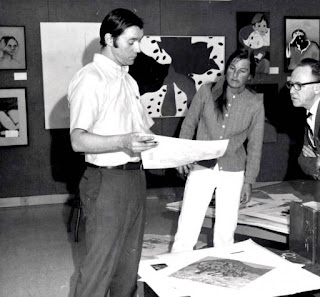On the fourth Monday in May we observe Memorial Day, a
commemoration that originated in the years immediately following the Civil War.
It was known in early years as Decoration Day because it provided an
opportunity to visit and adorn the graves of soldiers who made the ultimate
sacrifice in service to their country. Gen. John A. Logan, leader of the Union
veterans group Grand Army of the Republic, called for the first national day of
recognition to be held on May 30th, 1868. “We should guard their
graves with sacred vigilance,” Logan instructed, “Let pleasant paths invite the
coming and going of reverent visitors and fond mourners. Let no neglect, no
ravages of time, testify to the present or to the coming generations that we
have forgotten as a people the cost of a free and undivided republic.”
What began as a day devoted to the fallen servicemen
of the Union and Confederate Armies became something more in the wake of World
War I. America lost more than 100,000 military personnel during our two-year
involvement, and by 1920 those fallen men and women were also being honored in
Memorial Day ceremonies. The Great War left another mark on Memorial Day as
well. The red poppy – warn on a lapel or handed out on the corner – is a symbol
that can be traced back to the atrocities witnessed on the battlefields of WWI.
Many will be familiar with a 1915 poem penned by
Canadian physician John McCrea, “In Flander’s Field,” which opens with the
lines “In Flanders fields the poppies blow, Between the crosses, row on row.”
Less well known is the poem written in 1918 by a YMCA staffer named Moina
Michael, titled “We Shall Keep the Faith,” in which the author promises to wear
a poppy in honor of the dead. Michael is credited with creating the
now-ubiquitous tradition of wearing a red poppy on Memorial Day. By 1922 the
Veterans of Foreign Wars had adopted the sale of poppies a major fundraiser for
disabled service men and women.
The American flag plays an important role in most
Memorial Day commemorations. The traditional flag raising practice on the last
Monday in May is unique. After being briskly hoisted to the top, the flag is
solemnly returned to half-staff in memory of all those who have perished in
service. At noon the flag is returned to the top of its staff, symbolizing that
“their memory is raised by the living, who resolve not to let their sacrifice
be in vain, but to rise up in their stead and continue the fight for liberty
and justice for all,” according to the VFW Auxiliary.
Please take a moment on Monday to remember the true meaning
of Memorial Day, participate in a local program, or simply observe the National
Moment of Remembrance at 3:00pm. If you’d like to learn more about how World
War I impacted Latah County, please visit our exhibit in the McConnell Mansion.
Museum hours and additional information can be found at www.latahcountyhistoricalsociety.org.
LCHS Photo 15-02-006. A parade through Troy to celebrate Armistice Day, November 1918. The procession of local enlisted men was led by members of the Grand Army of the Republic and veterans of the Civil War.
LCHS Photo Loomis.D.01. Dudley Loomis as a
high school student in Moscow, before enrolling at Idaho State University.
Loomis joined the Army in 1917 at the onset of American involvement in WWI. He
was killed in a training accident and was the first local casualty of the war.
The American Legion Post #6 is named in his honor.
LCHS Photo 01-08-056. Local residents
participate in a Memorial Day ceremony at Ghormley Park in the 1960s, which
included decorating the Ghormley memorial stone. Adorning monuments with
flowers and flags is a tradition that goes back to the earliest commemorations
of Decoration Day.















